News
Six countries were banned from FIFA World Cup
- Germany and Japan – 1950 World Cup
After World War II cancelled the 1942 and 1946 editions of the World Cup, the tournament resumed in 1950. But because of the outcome of World War II, Germany and Japan were not allowed to join.
Uruguay was the winner, followed by Brazil in second place, Sweden in third place and Spain in fourth place.
- South Africa – 1970 – 1990 World Cups
During apartheid in South Africa, they faced multiple international boycotts. They were suspended by FIFA in 1963 and finally expelled in 1976.
South Africa hosted the 2010 edition and is the last African country to host the tournament.
- Mexico – 1990 World Cup
FIFA slapped a two-year ban on Mexico for fielding four over-age players.
This incident happened during the qualifying round of the World Junior Championship.
The 1990 World Cup was won by West Germany, who beat Argentina in the final. Italy and England were third and fourth respectively.
- Chile – 1994 World Cup
Chilean goalkeeper Roberto Rojas pretended to be injured by a flare thrown by a fan during a 1989 match against Brazil.
In fact, he used a blade hidden in his glove to cut himself, resulting in FIFA banning Chile from the 1994 tournament. Rojas was banned for life.
- Myanmar – 2006 World Cup
In 2002, Myanmar was eliminated from a qualifying match for the World Cup in Iran.
They were fined $23,500 by FIFA and banned from the 2006 tournament in Germany.
- Russia – 2022 World Cup
After invading Ukraine, they were condemned by many countries around the world.
FIFA decided to ban the Russian football team from participating in the World Cup in Qatar.
The first match of the 2022 World Cup will begin on November 20.
FIFA ලෝක කුසලානයට ක්රීඩා කිරීම තහනම් කර ඇති රටවල් හයක්
- Germany and Japan – 1950 World Cup
දෙවන ලෝක යුද්ධය හේතුවෙන් ලෝක කුසලානයේ 1942 සහ 1946 තරගාවලි අවලංගු කිරීමෙන් පසුව, තරඟාවලිය 1950 දී නැවත ආරම්භ විය.
නමුත් දෙවන ලෝක යුද්ධයේ ප්රතිඵලය නිසා ජර්මනියට සහ ජපානයට සම්බන්ධ වීමට ඉඩ නොලැබුණි.
උරුගුවේ ජයග්රාහකයන් වූ අතර බ්රසීලය දෙවන ස්ථානයත්, ස්වීඩනය තුන්වන ස්ථානයත්, ස්පාඤ්ඤය සිව්වන ස්ථානයත් හිමිකර ගත්හ.
- South Africa – 1970 – 1990 World Cups
දකුණු අප්රිකාවේ වර්ණභේදවාදය අතරතුර, ඔවුන් බහුවිධ ජාත්යන්තර වර්ජනයන්ට මුහුණ දුන්හ. FIFA විසින් 1963 දී ඔවුන්ව අත්හිටුවන ලද අතර අවසානයේ 1976 දී නෙරපා හරින ලදී.
2010 සංස්කරණයේ සත්කාරකත්වය දැරූ දකුණු අප්රිකාව තරගාවලියේ සත්කාරකත්වය දැරූ අවසන් අප්රිකානු රට වේ.
- Mexico – 1990 World Cup
වයස් සීමාවට වඩා වැඩි ක්රීඩකයින් 4 දෙනෙකු ඉදිරිපත් කළ මෙක්සිකෝවට FIFA විසින් වසර දෙකක තහනමක් පැනවීය.
ලෝක කනිෂ්ඨ තරගාවලියේ සුදුසුකම් ලැබීමේ වටයේදී මෙම සිදුවීම සිදුව තිබේ.
1990 ලෝක කුසලානය බටහිර ජර්මනිය විසින් දිනා ගන්නා ලද අතර ඔවුන් අවසන් මහා තරගයේදී ආර්ජන්ටිනාව පරාජය කරන ලදී. ඉතාලිය සහ එංගලන්තය පිළිවෙලින් තුන්වන සහ සිව්වන ස්ථානයේ පසුවිය.
- Chile – 1994 World Cup
චිලී ගෝල රකින්නා වන රොබර්ටෝ රොජාස් 1989 දී බ්රසීලයට එරෙහිව තරගයේදී රසිකයෙක් විසින් විසි කරන ලද ගිනිදැල් නිසා තුවාල වූ බව මවා පෑවේය.
ඇත්ත වශයෙන්ම, ඔහු සිය අත්වැසුම් තුළ සැඟවුණු තලයක් භාවිතා කර තමාවම කපා ගත් අතර, එහි ප්රතිඵලයක් ලෙස FIFA 1994 තරඟාවලියෙන් චිලී කණ්ඩායමට තහනම් කළේය. රොජාස්ට ජීවිතාන්තය දක්වා තහනමක් පැනවීය.
- Myanmar – 2006 World Cup
2002 වසරේ ඉරානයේ පැවැත්වීමට නියමිතව තිබූ ලෝක කුසලාන තරගාවලියට සුදුසුකම් ලැබීමේ තරගයකින් මියන්මාරය ඉවත් විය.
ඔවුන්ට FIFA විසින් ඩොලර් 23,500 ක දඩයක් නියම කරන ලද අතර ජර්මනියේ පැවති 2006 තරඟාවලියේ තරඟාවලිය තහනම් කරන ලදී.
- Russia – 2022 World Cup
යුක්රේනය ආක්රමණය කිරීමෙන් පසු ඔවුන් ලොව පුරා බොහෝ රටවල් විසින් හෙළා දකින ලදී.
රුසියානු පාපන්දු කණ්ඩායම කටාර් ලෝක කුසලානයට සහභාගී වීම තහනම් කිරීමට FIFA තීරණය කළේය.
2022 ලෝක කුසලානයේ පළමු තරගය නොවැම්බර් 20 වැනිදා ආරම්භ වේ.
FIFA உலகக் கோப்பையில் பங்கேற்க 6 நாடுகள் தடை
- ஜெர்மனி மற்றும் ஜப்பான் – 1950 உலகக் கோப்பை
இரண்டாம் உலகப் போர் உலகக் கோப்பையின் 1942 மற்றும் 1946 பதிப்புகளை ரத்து செய்த பிறகு, போட்டி 1950 இல் மீண்டும் தொடங்கியது.
ஆனால் இரண்டாம் உலகப் போரின் விளைவாக ஜெர்மனியும் ஜப்பானும் சேர அனுமதிக்கப்படவில்லை.
உருகுவே வெற்றியீட்டியது, பிரேசில் இரண்டாவது இடத்திலும், ஸ்வீடன் மூன்றாவது இடத்திலும், ஸ்பெயின் நான்காவது இடத்திலும் உள்ளன.
- தென்னாப்பிரிக்கா – 1970 – 1990 உலகக் கோப்பைகள்
தென்னாப்பிரிக்காவில் நிறவெறியின் போது, அவர்கள் பல சர்வதேச புறக்கணிப்புகளை எதிர்கொண்டனர். அவர்கள் 1963 இல் FIFA ஆல் இடைநீக்கம் செய்யப்பட்டனர் மற்றும் இறுதியாக 1976 இல் வெளியேற்றப்பட்டனர்.
2010 பதிப்பை நடத்திய தென்னாப்பிரிக்கா, போட்டியை நடத்தும் கடைசி ஆப்பிரிக்க நாடு.
- மெக்சிகோ – 1990 உலகக் கோப்பை
வயதுக்கு மேற்பட்ட நான்கு வீரர்களை களமிறக்கியதற்காக மெக்சிகோவுக்கு ஃபிஃபா இரண்டு ஆண்டு தடை விதித்தது.
உலக ஜூனியர் சாம்பியன்ஷிப் போட்டியின் தகுதிச் சுற்றின் போது இந்த சம்பவம் நடந்துள்ளது.
1990 உலகக் கோப்பையை இறுதிப் போட்டியில் அர்ஜென்டினாவை வீழ்த்தி மேற்கு ஜெர்மனி வென்றது. இத்தாலி மற்றும் இங்கிலாந்து முறையே மூன்றாவது மற்றும் நான்காவது இடத்தில் உள்ளன.
- சிலி – 1994 உலகக் கோப்பை
சிலி கோல்கீப்பர் ராபர்டோ ரோஜாஸ் 1989 ஆம் ஆண்டு பிரேசிலுக்கு எதிரான போட்டியின் போது ஒரு ரசிகரால் வீசப்பட்ட ஃப்ளேயால் காயம் அடைந்தது போல் நடித்தார்.
உண்மையில், அவர் தனது கையுறையில் மறைத்து வைத்திருந்த பிளேடைப் பயன்படுத்தி தன்னைத் தானே வெட்டிக்கொண்டார், இதன் விளைவாக ஃபிஃபா 1994 போட்டியில் சிலியை தடை செய்தது. ரோஜாஸ்க்கு வாழ்நாள் தடை விதிக்கப்பட்டது.
- மியான்மர் – 2006 உலகக் கோப்பை
2002 இல், ஈரானில் நடைபெறவிருந்த உலகக் கோப்பைக்கான தகுதிச் சுற்றில் இருந்து மியான்மர் வெளியேறியது.
அவர்களுக்கு FIFA $23,500 அபராதம் விதித்தது மற்றும் ஜெர்மனியில் 2006 போட்டியில் இருந்து தடை செய்யப்பட்டது.
- ரஷ்யா – 2022 உலகக் கோப்பை
உக்ரைனை ஆக்கிரமித்த பிறகு, அவர்கள் உலகின் பல நாடுகளால் கண்டனம் செய்யப்பட்டனர்.
கத்தாரில் நடைபெறும் உலகக் கோப்பை கால்பந்து போட்டியில் ரஷ்ய கால்பந்து அணி பங்கேற்க தடை விதிக்க ஃபிஃபா முடிவு செய்துள்ளது.
2022 உலகக் கோப்பையின் முதல் போட்டி நவம்பர் 20 ஆம் தேதி தொடங்குகிறது.
Cricket
Sanath Jayasuriya to Step Down as Sri Lanka Head Coach After T20 World Cup 2026
Sri Lanka head coach Sanath Jayasuriya has confirmed that he will step down from his role following the ICC Men’s T20 World Cup 2026, bringing clarity to ongoing speculation surrounding his future with the national team.
Although Jayasuriya’s current contract with Sri Lanka Cricket (SLC) extends beyond the World Cup, multiple media reports indicate that he has already taken a personal decision not to continue in the role after the tournament.
Coaching Journey and Key Milestones
Jayasuriya’s tenure as national head coach began in July 2024, when he was appointed interim head coach ahead of a demanding home series against India. That appointment proved pivotal, as Sri Lanka went on to record a historic ODI series victory over India, their first in several decades. The result prompted Sri Lanka Cricket to confirm Jayasuriya as full-time head coach later that year.
Prior to taking over the national side, Jayasuriya had been involved with Sri Lanka Cricket as a consultant at the National High Performance Centre since December 2023, contributing to player development and long-term planning.
Record and Performance Overview
Under Jayasuriya’s leadership, Sri Lanka have played 60 international matches across all three formats, registering 29 wins and 29 losses, with two no results. The numbers reflect a transitional phase for the team, marked by rebuilding, experimentation, and gradual progress rather than consistent dominance.
While the team has shown improvement in Tests and ODIs, Jayasuriya has acknowledged that T20 cricket remains an area requiring further refinement, particularly in maintaining batting momentum and executing disciplined bowling during decisive phases of matches.
Focus on World Cup Preparation
Looking ahead, Jayasuriya has highlighted upcoming home series against Pakistan and England as crucial preparation opportunities ahead of the T20 World Cup. He believes these contests will allow Sri Lanka to finalise player combinations, sharpen tactical decision-making, and test performances under pressure in familiar conditions.
Jayasuriya’s connection with Sri Lanka’s World Cup success is deeply rooted. He was Player of the Tournament during Sri Lanka’s iconic 1996 ODI World Cup victory and later served as Chairman of Selectors when the national team lifted the 2014 T20 World Cup. Now, he is aiming to contribute to a potential third World Cup triumph, this time from the coach’s chair.
SLC Response and Future Outlook
Sri Lanka Cricket Chairman Shammi Silva has publicly expressed satisfaction with Jayasuriya’s work, praising his hands-on coaching approach and close engagement with players. Speaking at a recent media briefing, Silva stated that formal discussions regarding Jayasuriya’s future will take place after the T20 World Cup, leaving open the possibility of an extension should circumstances permit.
In a separate development, Silva also confirmed that Sri Lanka Cricket plans to appoint a foreign head coach for the national women’s team, marking a shift from the current setup under local coach Rumesh Ratnayake. The move forms part of a broader strategy to further professionalise and strengthen the women’s cricket programme.
As Sri Lanka build toward the 2026 T20 World Cup on home soil, Jayasuriya’s remaining tenure is expected to focus on consolidation, clarity, and competitive readiness — with his legacy to be assessed once the global tournament concludes.
Cricket
Harmanpreet Leads from the Front as India Women Seal 5–0 Clean Sweep Over Sri Lanka
India Women capped off a dominant tour with another composed performance, defeating Sri Lanka Women by 15 runs in the fifth and final T20I to complete a 5–0 clean sweep of the series. The result underlined India’s superiority throughout the tour, as they consistently controlled key phases of play and delivered under pressure.
Batting first, India Women posted an imposing 175 for 7 from their 20 overs. The innings was anchored by captain Harmanpreet Kaur, who led from the front with a commanding 68 off 43 balls. After early setbacks that saw Shafali Verma, Gunalan Kamalini and Harleen Deol depart inside the powerplay, India required stability — and Harmanpreet provided exactly that.
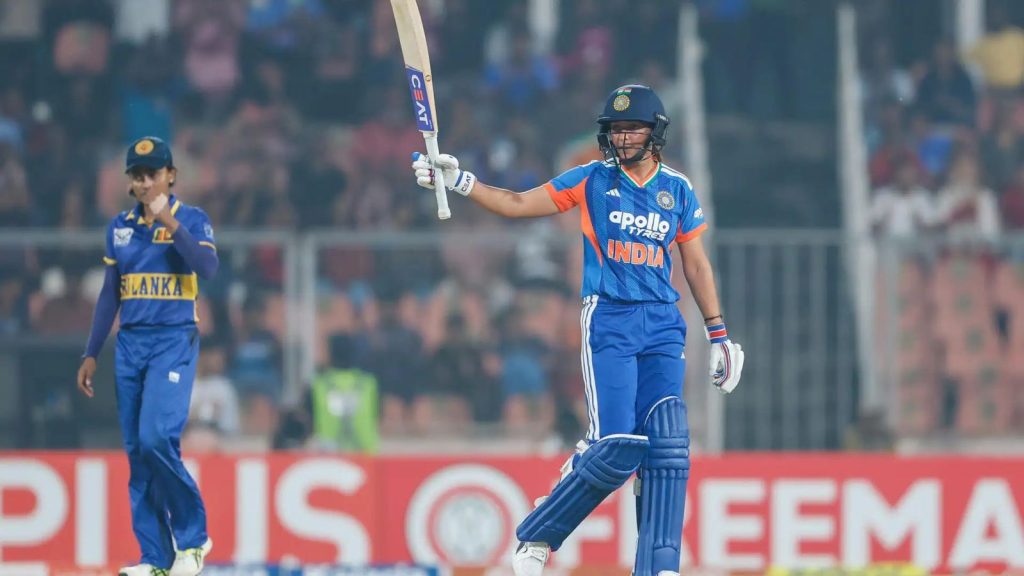
The skipper rotated the strike efficiently before accelerating with authority, striking nine boundaries and a six to maintain momentum. Support came in patches, with Amanjot Kaur contributing a useful 21, but it was the late surge that lifted India to a formidable total. Arundhati Reddy produced a stunning cameo, remaining unbeaten on 27 from just 11 deliveries, her clean striking in the death overs decisively shifting momentum in India’s favour.
Among the Sri Lankan bowlers, Kavisha Dilhari and Chamari Athapaththu were the standouts, claiming two wickets apiece, but the attack struggled to contain India in the closing stages.
Chasing 176, Sri Lanka Women responded with intent and determination. Hasini Perera starred at the top of the order with a fluent 65 off 42 balls, while Imesha Dulani compiled a composed 50, keeping the chase alive with a crucial partnership that threatened to tilt the contest.
India, however, showcased their experience and composure. Timely breakthroughs in the middle overs stalled Sri Lanka’s momentum, with Deepti Sharma, Sneh Rana, Vaishnavi Sharma and Shree Charani all making important contributions with the ball. Sharp fielding — highlighted by a crucial run-out — further tightened India’s grip on the match.
Despite a late push from Rashmika Sewwandi, Sri Lanka finished on 160 for 7, falling 15 runs short of the target.
The victory sealed a comprehensive 5–0 series whitewash for India Women, reflecting their consistency, squad depth, and tactical clarity throughout the series. Harmanpreet Kaur’s leadership and match-winning performance in the final game perfectly encapsulated India’s dominance as they closed the tour on a resounding high.
Brief Scores
India Women 175/7 in 20 overs
Harmanpreet Kaur 68 (43), Arundhati Reddy 27* (11)
Kavisha Dilhari 2/11, Chamari Athapaththu 2/21
Sri Lanka Women 160/7 in 20 overs
Hasini Perera 65 (42), Imesha Dulani 50 (39)
Deepti Sharma 1/28, Sneh Rana 1/3
News
Sri Lanka Rugby Approves National Referee Development Plan and Elite Referee Panel
Sri Lanka Rugby (SLR) has granted conditional approval for the implementation of a National Referee Development Plan and the establishment of an Elite Referee Panel, subject to final ratification by the Sri Lanka Rugby Council.
According to an official press release, the initiative has been introduced in response to a national shortage of qualified rugby referees, a challenge that has impacted domestic competitions in recent seasons. The proposed development plan includes a one-time intake of 30 referee candidates, aimed at strengthening officiating standards across all levels of the game.
Structured National Intake Process
Under the approved framework, referee candidates will be drawn from three distinct sources. These include nominations from the Tri-Forces, selections through an open national application process, and candidates identified through existing rugby structures. All selected participants will undergo a standardised training and accreditation pathway implemented by Sri Lanka Rugby, aligned with World Rugby guidelines and best practices.
Sri Lanka Rugby stated that the programme is designed to create a sustainable pipeline of referees, ensuring consistency, professionalism, and improved match control in domestic competitions.
Elite Referee Panel Established
In parallel, SLR has approved the formation of an Elite Referee Panel, which will consist of the country’s top-performing referees. This panel is expected to officiate high-level domestic matches and serve as a talent pool for regional and international assignments.
The Elite Panel will operate under clearly defined performance, fitness, and assessment criteria, with ongoing evaluations to maintain officiating standards.
Interim Measures for Ongoing Competitions
As an immediate interim solution, Sri Lanka Rugby has decided to request two foreign referees from Asia Rugby to officiate matches from the Super Round stage onwards in the current competition structure. This move aims to ensure neutrality, consistency, and fairness during decisive matches while local referee capacity is strengthened.
Role of Referees’ Society Recognised
The Executive Committee also acknowledged the long-standing contribution of the Sri Lanka Society of Rugby Football Referees, confirming that the organisation will continue to play a key role in grassroots referee development and education within the revised framework.
Focus on Match Integrity and Player Safety
Sri Lanka Rugby emphasised that the approved reforms are part of a broader effort to enhance match integrity, player safety, and public confidence in officiating, as well as to align local rugby administration with international standards.
The final implementation of the National Referee Development Plan and the Elite Referee Panel remains subject to formal approval by the Sri Lanka Rugby Council
-
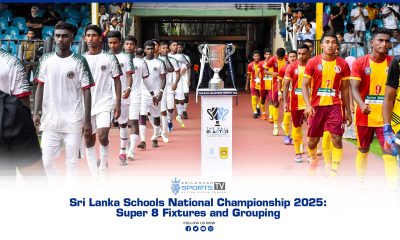
 Football11 months ago
Football11 months agoSri Lanka Schools National Championship 2025: Super 8 Fixtures and Grouping
-

 News11 months ago
News11 months ago2025 Schools Rugby Season Set to Thrill Fans with Knockout and League Action
-

 Cricket7 months ago
Cricket7 months agoNuwan Thushara Shines as RCB Storms into IPL 2025 Final
-

 Live4 years ago
Live4 years agoLive Broadcast of Syria vs Sri Lanka | AFC U23 Asian Championship Qualification
-
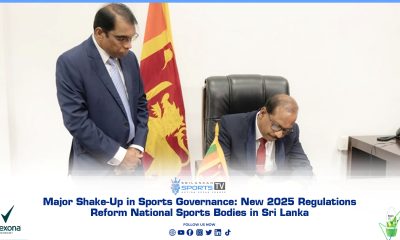
 News7 months ago
News7 months agoMajor Shake-Up in Sports Governance: New 2025 Regulations Reform National Sports Bodies in Sri Lanka
-

 Football12 months ago
Football12 months agoFFSL Rebrands Division-1 as ‘League-One’ with a Bold New Vision
-
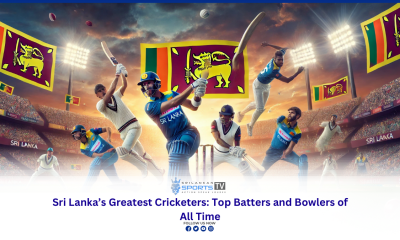
 Cricket11 months ago
Cricket11 months agoSri Lanka’s Greatest Cricketers: Top Batters and Bowlers of All Time
-
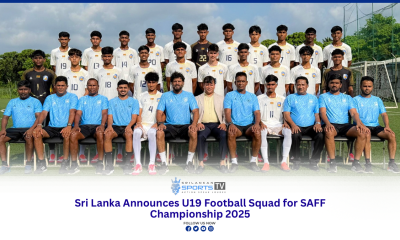
 Football8 months ago
Football8 months agoSri Lanka Announces U19 Football Squad for SAFF Championship 2025







